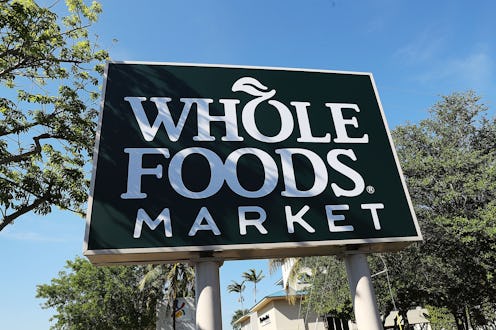Life
Whole Foods' Affordable Offshoot Is Being Replaced With Regular Whole Foods Markets

It’s time to say goodbye to a small set of Whole Foods stores you might not have even known existed. Whole Foods 365 stores are going away and are getting converted into regular Whole Foods stores by the end of the year, Yahoo Finance reports. All 12 locations will remain open, a Whole Foods spokesperson told Yahoo Finance, but they’ll get new signage, product assortments, and back-end distributions in line with the regular Whole Foods Markets.
Whole Foods opened its first 365 by Whole Foods stores in May 2016 — before the grocery chain was acquired by Amazon — as smaller, less expensive versions of its flagship stores, Business Insider reports. The 365-stores are 30,000 to 25,000 square feet, much smaller than the 40,000 square feet of the conventional Whole Foods super market, says Yahoo Finance. According to Business Insider, the 365 stores focused on prepared foods and were cheaper to build and operate than the flagship stores.
“When we launched our Whole Foods Market 365 stores, the intention was to create a more value-focused and streamlined shopping experience that maintained the integrity of Whole Foods' quality in a convenient format that's less expensive to build and operate,” Whole Foods CEO John Mackey said in an email, according to Business Insider.
“We have been successful in achieving these goals,” Mackey continued in his email. “However, as we have been consistently lowering prices in our core Whole Foods Market stores over the past year, the price distinction between the two brands has become less relevant. As the company continues to focus on lowering prices over time, we believe that the price gap will further diminish. As a result, we have decided that it's in the best long-term interest of the company to concentrate our efforts on growing the core Whole Foods Market brand moving forward.” Mackey said in his email that no team members will be displaced as a result of these changes, according to Business Insider.
If the 365 brand sounds familiar to you, that's because that's the name for Whole Foods' in-house staples; you can find the 365 logo on Whole Foods' versions of things like mustard or paper towels. That brand will not be affected by the store changes.
Amazon acquired Whole Foods in June 2017 for $13.7 billion, according to CNN. Since the acquisition, Amazon has cut the prices of many groceries at Whole Foods by as much as 50 percent, such as avocados, eggs, fruit, fish, and prepared foods, CNN reports. The discounts brought a 17 percent increase in foot traffic to Whole Foods stores, according to CNN. Customers also started seeing Amazon tech products like Kindles and Echos right inside Whole Foods stores, says CNN, and Amazon installed lockers in Whole Foods stores so customers could pick up their online purchases.
“It’s logical just to convert these few stores into Whole Foods, keep locations that have already got the leases on them,” Phil Lempert, a grocery industry analyst at Supermarket Guru, told Yahoo Finance. “I think that it's smart to just have a singular focus.”
If you haven't had a chance to shop at a 365 store before today, don't worry. The 365 stores are all staying open; they're just getting converted into traditional Whole Foods Markets, with all the discounts that Whole Foods and Amazon have been integrating into the flagship stores since the acquisition.